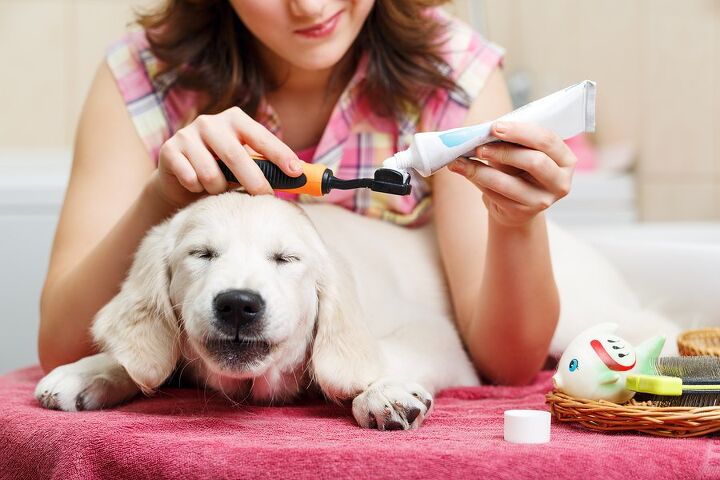Toothy Trouble: Periodontal Disease in Dogs

According to the American Veterinary Dental College, periodontal disease is not only the most common clinical condition seen in cats and dogs, but it is also one of the most preventable. Simple dental care is generally enough to prevent your dog or cat from developing this serious problem and it only takes a few minutes of your time. The more you know about periodontal disease in dogs, the better equipped you are to prevent it.
What is Periodontal Disease in Dogs?
Also known as gum disease, periodontal disease in dogs can be serious and it can also develop quickly. Many dogs and cats will develop some kind of periodontal disease by the time they are three years old. Unfortunately, the signs of periodontal disease are frequently not obvious so many pet parents miss it until the problem has progressed to a severe degree. Bad breath is the most common early sign of periodontal disease, but many pet parents mistakenly believe that bad breath is normal for pets so they ignore it.
Related: 8 Tips To Improve Your Dog’s Dental Health
Periodontal disease starts when bacteria in the dog’s mouth forms a film on the surface of the teeth – this film is known as plaque. After the plaque forms, minerals in the dog’s saliva interact with it, hardening it into something called dental calculus, or tartar. The tartar is firmly attached to the tooth’s surface but it can also start to spread under the dog’s gum line. When this happens, the bacteria in the plaque can actually start to secrete toxins which can damage the dog’s gums, kill the tooth, and even cause bacteria to leech into the dog’s bloodstream. In some cases, the bacteria stimulates an auto-immune response which causes the dog’s body to start attacking its own healthy tissues.
Treatment and Prevention of Periodontal Disease
While it is unfortunate that periodontal disease is so common, it is fortunate that it is highly preventable and there are treatment options available. In the early stages, dogs with periodontal disease typically do not display any symptoms – by the time you start to realize that something is wrong, the disease has likely progressed to the point where it is causing your dog chronic pain. At this point in the disease you may notice signs like red or bleeding gums, loose teeth, blood in the water bowl, ropey saliva, and chewing on one side of the mouth. In addition to causing these symptoms, periodontal disease can also increase your dog’s risk for heart, liver, and kidney problems.
Related: Why Dental Health Is So Important For Dogs?
Treatments for periodontal disease vary depending on the stage of the disease. In the early stages, an oral cleaning below the dog’s gum line may be the only form of treatment necessary. Once pockets have formed between the gum and the tooth, the tissue must be cleaned and treated for reattachment. In stage three, some level of bone loss is likely and the disease tissue and tooth must be removed. In the fourth stage, bone loss is over 50 percent and the teeth must be extracted. Your veterinarian will perform a number of tests as well as bloodwork and x-rays to determine which stage your dog’s periodontal disease is in.
The best method of prevention for periodontal disease is to brush your dog’s teeth on a regular basis – this can be using a tooth brush, or specially made toys, treats, foams and water additives. In addition to keeping your dog’s teeth clean at home, you should also make sure your dog gets regular oral exams and cleanings from the veterinarian.
Your dog’s dental health is incredibly important so it isn’t something you should ignore. If you don’t already check in on your dog’s teeth on a regular basis or if he hasn’t had an oral exam or cleaning for a while, it’s time to schedule one.

Kate Barrington is the loving owner of two cats (Bagel and Munchkin) and a noisy herd of guinea pigs. Having grown up with golden retrievers, Kate has a great deal of experience with dogs but labels herself a lover of all pets. Having received a Bachelor's degree in English, Kate has combined her love for pets and her passion for writing to create her own freelance writing business, specializing in the pet niche.
More by Kate Barrington























